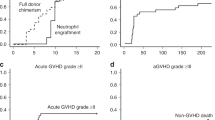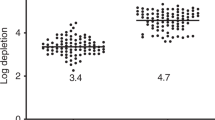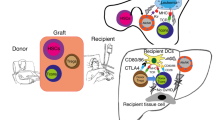Summary:
A total of 11 high-risk Korean acute myeloid leukemia (AML) patients received stem cell transplantation from human leukocyte antigen (HLA) haploidentical donors. Specifically, for eight patients with 2–3 mismatched antigens and bidirectional vectors, we used a newly designed conditioning regimen that consists of total body irradiation, busulfex, ATG, and fludarabine. The median number of CD34+ cells infused was 15.4 × 106/kg (range, 8–21.2). These patients received neither graft-versus-host disease (GvHD) prophylaxis nor post transplantation G-CSF. All of the patients who were followed up for a median of 6 months (range, 17 days–28 months) showed stable primary engraftment and had no acute GvHD or transplant-related mortality for 100 days post transplant. Three patients with high-risk or refractory disease eventually died in relapse, even with GvH-directed NK alloreactivity. However, the patients in complete remission (CR), with the exception of one patient who is alive at 18 months EFS, died at 4, 6, and 8 months post transplantation due to infections that were associated with delayed immune recovery. Our findings suggest that haploidentical transplantation represents a feasible treatment for patients with high-risk AML in CR, provided that a plan for the enhancement of immune recovery is implemented.
This is a preview of subscription content, access via your institution
Access options
Subscribe to this journal
Receive 12 print issues and online access
$259.00 per year
only $21.58 per issue
Buy this article
- Purchase on Springer Link
- Instant access to full article PDF
Prices may be subject to local taxes which are calculated during checkout

Similar content being viewed by others
References
Chao NJ, Koh LP, Long GD et al. Adult recipients of umbilical cord blood transplants after nonmyeloablative preparative regimens. Biol Blood Marrow Transplant 2004; 10: 569–575.
Chao NJ, Koh LP . Umbilical cord blood transplantation in adults using myeloablative and nonmyeloablative preparative regimens. Biol Blood Marrow Transplant 2004; 10: 1–22.
Aversa F, Tabilio A, Terenzi A et al. Successful engraftment of T-cell-depleted haploidentical ‘Three-loci’ incompatible transplants in leukemia patients by addition of recombinant human granulocyte colony-stimulating factor-mobilized peripheral blood progenitor cells to bone marrow inoculum. Blood 1994; 84: 3948–3955.
Aversa F, Tabilio A, Velardi A et al. Treatment of high-risk acute leukemia with T-cell-depleted stem cells from relapsed donors with one fully mismatched HLA haplotype. N Engl J Med 1998; 339: 1186–1193.
Aversa F, Terenzi A, Carotti A et al. Improved outcome with T-cell-depleted bone marrow transplantation for acute leukemia. J Clin Oncol 1999; 17: 1545–1550.
Martelli MF, Reisner Y . Haploidentical ‘megadose’ CD34+ cell transplants for patients with acute leukemia. Leukemia 2002; 16: 404–405.
Rachamim N, Gan J, Segall H et al. Tolerance induction by “Megadose” hematopoietic transplants. Transplantation 1998; 65: 1386–1393.
Handgretinger R, Schumm M, Lang P et al. Transplantation of megadoses of purified haploidentical stem cells. Ann NY Acad Sci 1999; 872: 351–361.
Kim HJ, Park CY, Park YH et al. Successful allogeneic hematopoietic stem cell transplantation using triple agent immunosuppression in severe aplastic anemia patients. Bone Marrow Transplant 2003; 31: 79–86.
Aversa F, Terenzi A, Felicini R et al. Haploidentical stem cell transplantation for acute leukemia. Int J Hematol 2002; 76 (Suppl. I): 165–168.
Aversa F, Terenzi A, Ballanti S et al. Improving outcomes of haploidentical transplants for acute leukemia. Biol Blood Marrow Transpl 2003; 9: 9a.
Kim HJ, Park SJ, Im HW et al. The association of HLA antigen and GvHD in allogeneic hemopoietic stem cell transplantation with histocompatible sibling donor: a single-center experience in Korea. Int J Hematol 2002; 76: 267–271.
Fry TJ, Mackall CL . Interleukin-7: from bench to clinic. Blood 2002; 99: 3892–3904.
Min D, Taylor PA, Panoskaltsis-Mortari A et al. Protection from thymic epithelial cell injury by keratinocyte growth factor: a new approach to improve thymic and peripheral T-cell reconstitution after bone marrow transplantation. Blood 2002; 99: 4592–4600.
Ruggeri L, Capanni M, Volpi I et al. Role of natural killer cell alloreactivity in HLA-mismatched hematopoietic stem cell transplantation. Blood 1999; 94: 333–339.
Ruggeri L, Capanni M, Urbani E et al. Effectiveness of donor natural killer cell alloreactivity in mismatched hematopoietic transplants. Science 2002; 295: 2097–2100.
Slovak ML, Kopecky KJ, Cassileth PA et al. Karyotypic analysis predicts outcome of preremission and postremission therapy in adult acute myeloid leukemia: a Southwest Oncology Group/Eastern Cooperative Oncology Group study. Blood 2000; 96: 4075–4083.
van Rood JJ, Loberiza Jr FR, Zhang MJ et al. Effect of tolerance to noninherited maternal antigens on the occurrence of graft-versus-host disease after bone marrow transplantation from a parent or an HLA-haploidentical sibling. Blood 2002; 99: 1572–1577.
Shimazaki C, Ochiai N, Uchida R et al. Non-T-cell–depleted HLA haploidentical stem cell transplantation in advanced hematologic malignancies based on the feto-maternal michrochimerism. Blood 2003; 101: 3334–3336.
Acknowledgements
This study was supported in part by a grant of the National Cancer Control R&D Program 2003, Ministry of Health & Welfare, Republic of Korea.
Author information
Authors and Affiliations
Corresponding author
Rights and permissions
About this article
Cite this article
Kim, HJ., Min, WS., Kim, YJ. et al. Haplotype mismatched transplantation using high doses of peripheral blood CD34+ cells together with stratified conditioning regimens for high-risk adult acute myeloid leukemia patients: a pilot study in a single Korean institution. Bone Marrow Transplant 35, 959–964 (2005). https://doi.org/10.1038/sj.bmt.1704900
Received:
Accepted:
Published:
Issue Date:
DOI: https://doi.org/10.1038/sj.bmt.1704900



